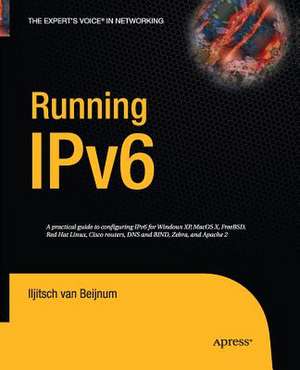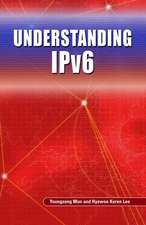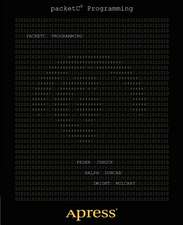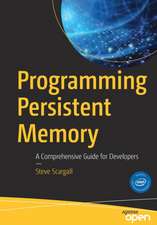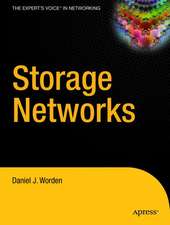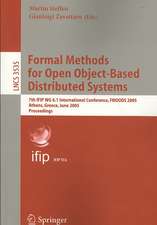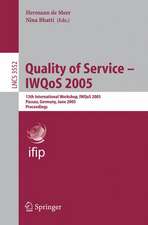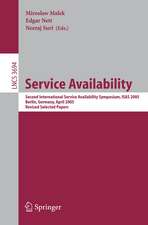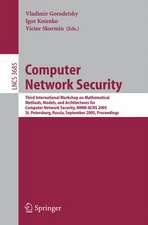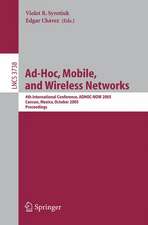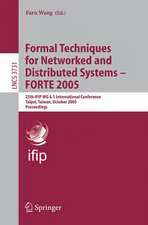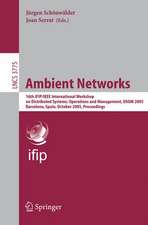Running IPv6
Autor Iljitsch van Beijnumen Limba Engleză Paperback – 5 noi 2014
Running IPv6 compares and contrasts IPv6 to IPv4, and discusses the advantages and disadvantages of each. Because most major software and hardware vendors have adopted IPv6, the focus of this book is to leverage your existing knowledge of IPv4 and to help you apply that knowledge to the newer protocol.
| Toate formatele și edițiile | Preț | Express |
|---|---|---|
| Paperback (2) | 220.53 lei 17-23 zile | +16.96 lei 5-11 zile |
| Apress – 6 iun 2012 | 220.53 lei 17-23 zile | +16.96 lei 5-11 zile |
| Apress – 5 noi 2014 | 357.86 lei 43-57 zile | |
| Hardback (1) | 337.05 lei 43-57 zile | |
| Apress – 17 noi 2005 | 337.05 lei 43-57 zile |
Preț: 357.86 lei
Preț vechi: 447.33 lei
-20% Nou
Puncte Express: 537
Preț estimativ în valută:
68.51€ • 70.46$ • 56.83£
68.51€ • 70.46$ • 56.83£
Carte tipărită la comandă
Livrare economică 17 februarie-03 martie
Preluare comenzi: 021 569.72.76
Specificații
ISBN-13: 9781430211747
ISBN-10: 1430211741
Pagini: 288
Ilustrații: XIX, 266 p.
Dimensiuni: 191 x 235 x 19 mm
Greutate: 0.5 kg
Ediția:Softcover reprint of the original 1st ed.
Editura: Apress
Colecția Apress
Locul publicării:Berkeley, CA, United States
ISBN-10: 1430211741
Pagini: 288
Ilustrații: XIX, 266 p.
Dimensiuni: 191 x 235 x 19 mm
Greutate: 0.5 kg
Ediția:Softcover reprint of the original 1st ed.
Editura: Apress
Colecția Apress
Locul publicării:Berkeley, CA, United States
Public țintă
Professional/practitionerCuprins
IPv6. What is IPv6. Where did it come from and why. Differences between IPv4, IPv6 and other protocols. Benefits. Myths.- IPv6-enabling hosts. IPv6 addressing. Address structure. Address representation. Scoping. The IPv6 address space. Address assignment and allocation policies. Address usage guidelines. OS requirements. FreeBSD. MacOS X. Linux. Windows. Native IPv6. Enabling/disabling IPv6 for an interface. IPv6 in a non-IPv6 environment (link local and multicast addresses). Autoconfiguration. Manual configuration. Tunnels. Manually configured tunnels. 6to4. The DNS problem. Diagnostics. ping6 and traceroute6. ifconfig. Netstat. Route.- Routing. Simple routing. Configuring a host to be a router. Enabling IPv6 and configuring tunnels on a Cisco router. RIPng. With Zebra on FreeBSD/Linux. On a Cisco. OSPF for IPv6. With Zebra on FreeBSD/Linux. On a Cisco. Re IPv4. Taking advantage of link local addresses. Tunneling. Integrated interior routing. Multiprotocol BGP. With Zebra on FreeBSD/Linux. On a Cisco. Interdomain routing guidelines. Quality of service.- Security. Spoofing. Anti-spoofing filters. Tunnels and IPv4 firewalls. 6to4. Port scanning. Firewalling IPv6. tcpd / tcp wrappers on FreeBSD, MacOS and Linux. ipfw on FreeBSD, MacOS and Linux. Windows IPv6 firewalling??? Router access lists. IPsec. Tunnel mode vs transport mode. ESP and AH. IPsec with IPv4 vs IPsec with IPv6. Privacy concerns. Rogue IPv6 routers. Old IPv4 bugs in new IPv6 implementations.- The DNS. Putting IPv6 addresses in the DNS. Setting up reversed service for IPv6. Configuring BIND for IPv6.- Applicati ons. Basic tools. Web browsers Apache 2. sendmail.- The transition. Tunnels. Running dual stack. Proxies. Translation using faith or NAT.- Under the hood. IPv6 and Ethernet. sysctl settings. Optionsin IPv6 packets.- Casualties of war. Shipworm/Toredo. 6over4/ISATAP. DHCPv6. A6 DNS records. The site local controversy. Multihoming in IPv6.
Notă biografică
Iljitsch van Beijnum is a freelance network specialist and writer in the Netherlands. He is the author of BGP (O'Reilly, 2002) and is active within the Internet Engineering Task Force (IETF), especially within the Multihoming in IPv6 (multi6) working group.
Caracteristici
Covers IPv6 on Windows XP, MacOS X, FreeBSD, and Linux On the cusp of the next Internet breakthrough. Network administrators will have to accommodate this technology eventually; this book will help them become more proficient IPv6 is gaining popularity, even the US government is starting to adopt it
